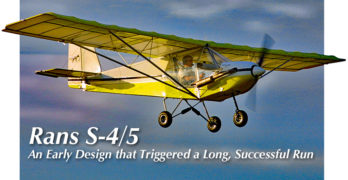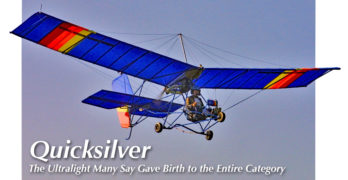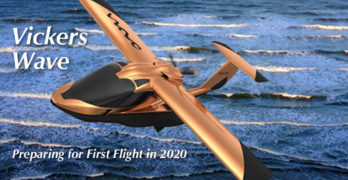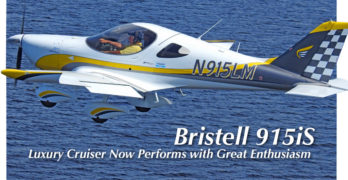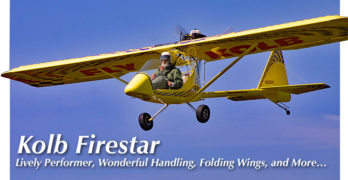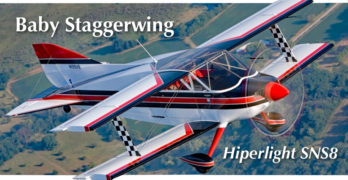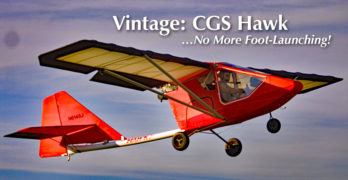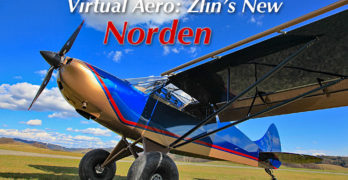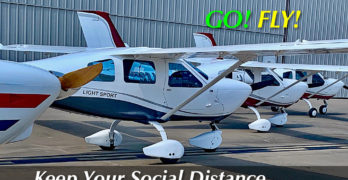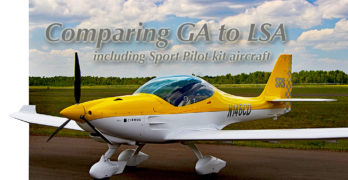This first year I ever saw Randy Schlitter fly one his models at an airshow seems a hundred years ago. Indeed, since that distant memory at Sun ‘n Fun, this Kansas company has created a profusion of designs and delivered nearly 5,000 aircraft. To say it has been a great run qualifies as a significant understatement.
Today’s S-21 Outbound (pilot report video) or S-20 Raven (pilot report video) seem a long ways off from those very early models yet it does not take an expert eye to see they are clear descendants from the original Rans aircraft.
What began this fascinating evolution of a light airplane company started almost 40 years ago — here’s a report on the very first model, still flying! That humble little Coyote (Kansas is a U.S. prairie state so coyotes are a logical name) began something great but it remains a wonderful light airplane that you can buy today for a song.
Search Results for : flight design ct
Not finding exactly what you expected? Try our advanced search option.
Select a manufacturer to go straight to all our content about that manufacturer.
Select an aircraft model to go straight to all our content about that model.
Ultralight April 2020 — Eighth in the Vintage Series: Quicksilver MX
Ah, the Quicksilver! Where to start with this veritable icon of the ultralight sector?
With more than 15,000 flying, it even outranks Van’s Aircraft for kit aircraft that made it into the air — although Van’s has sold more kits in total and no one disputes the Western brand’s leadership position.
The earliest Quicksilvers were hang gliders (last photo). Engines came later but at first the weight-shift seat stayed (nearby image). The pilot had lateral control — still by weight shift — but via lines that moved surfaces. Pitch, however, was fully controlled by the pilot moving his or her body.
Those were fun days and provided wonderful memories (yes, I flew them as weight-shift aircraft). Yet the brand went on to vastly greater development. In this article, our focus is on the original three-axis control model, the oh-so-famous MX (multiple axis).
Quicksilver MX
Quicksilver’s MX entered the market in the early 1980s, like all the models featured in our Vintage Ultralight series.
Update from Vickers Aircraft and their Wave Light-Sport Aircraft Amphibian
The Coronavirus madness is far from being a U.S. problem. Naturally, we tend to focus on our own part of the world …as we must. Yet even far-away countries are also struggling — to protect citizens and to keep their economies afloat. It simply has to improve as the present situation cannot last.
Despite the challenging situation, progress continues in the distant nation of New Zealand. As in many nations, wide-ranging business support has also been rolled out, softening the impact of the lockdown and allowing New Zealand to move forward with minimal long-term disruption.
Update from Vickers Aircraft
Chief designer, founder, and visionary (and company namesake), Paul Vickers, wrote, “2020 is quickly turning into a very memorable year at Vickers Aircraft for numerous reasons.”
“Along with much of the world,” Paul continued in early April, “New Zealand is feeling the effects of the Covid-19 pandemic with a state of emergency declared.
Virtual Sun ‘n Fun 2020 — 5 Light Aircraft You Might Have Seen in Lakeland
While I continue to worry about the cash crunch faced by two of my favorite shows, I am still driven to provide content as if those shows had occurred this year and not been postponed to 2021.
Of course, I refer to Aero Friedrichshafen and Sun ‘n Fun, the latter my focus for this post.
Here I will relate five aircraft you might have seen in Lakeland last week …before it was bumped to early May, but which is now off until April 2021.
I admit I secretly hoped for good news in these sad cancellations that might allow me to attend both events in 2021. I had to pick one over the other in 2020 as they were exactly opposite one another. Unfortunately for my schedule, the year-long postponement didn’t change anything. Sun ‘n Fun 2021 will be 13-18 of April while Aero 2021 is planned for 14-17 April.
Ultralight April 2020 — Fifth in the Vintage Series: Kolb Firestar
Amazingly enough, here in 2020, we have noticeably returned to our roots in very light aircraft. Almost 40 years after Mike Sacrey and his team at FAA created the still-incredible Part 103, one leading brand from those days is not only still in business and thriving, but they are largely building similar aircraft to four decades back.
The man you saw on the lead photo is the famed Dick Rahill, a one-man flying machine flying his machine at Sun ‘n Fun more capably than any robot. Over and over, Dick would blast off in the bright yellow Firestar that seemed attached to him. He’d make one quick pattern from the turf runway in Paradise City at Sun ‘n Fun only to land, jump right back in the takeoff line, and repeat. Launch, circle, land, repeat… over and over. It seemed like every other airplane taking off was Dick and his FireStar.
Ultralight April 2020 — Fourth in the Vintage Series: Hiperlight SNS 8 Biplane
As we continue with this fourth in a series of ten about very affordable light aircraft from earlier times, we stress again that all the aircraft presented in this series still have some essential qualities that warranted their inclusion.
First, these are all aircraft with which Videoman Dave and I are personally familiar. I have flown all but one on the list and I believe Dave has flown all of them. So, we come to the series with real experiences in these flying machines. It has been a while for many of them, but assuming maintenance is good (see the important message at the end), this can be reasonable for many pilots to consider. However, as with any used aircraft, the buyer must be aware. Neither Dave nor I can comment on any one particular aircraft.
Second, and with the maintenance message firmly planted in your mind, all the models in this Vintage Ultralight series still have parts available from current-day producers.
Ultralight April 2020 — Second in the Vintage Series: CGS Hawk
Way back when, long before the birth of the Light-Sport Aircraft segment (in 2004), lots of us flew ultralights. They were barely more than powered hang gliders — except one.
Before 1982 these lightest-of-all aircraft were required to be foot-launchable. It’s true. I once staggered into the air partly carrying, partly dragging a Quicksilver. I got airborne thanks to a generous 15 mph headwind that provided about three quarters of the speed I needed for… um, you can’t call it “rotation,” but to get enough lift that I could sit down.
Yes, “sit down.” You didn’t think I ran for take off while sitting comfortably belted into a secure seat did you? Nope, that Quicksilver had a literal swing seat and a special rear axle that allowed a full stride of your legs.
OK, that requirement proved futile and FAA later dropped it, but one guy in particular drove that older requirement into the annals of history.
Virtual Aero Friedrichshafen — Zlin Aviation’s New Norden Sportplane
Had not both shows been cancelled or postponed, I would be gearing up for Sun ‘n Fun and Aero Friedrichshafen. The important spring events were due to start in less than a week.
Now, Aero is put off until 2021 and Sun ‘n Fun is about three weeks away from a Lakeland city-imposed final decision date (on April 17) regarding the new planned date of May 5-10, 2020. (I’m keeping my hopes up that our friends at that event will be able to launch their spring celebration of flight.)
To help all of us through the next few weeks, I will be posting virtual airshow material — that is, I’ll write about aircraft you would have seen had you been able to attend the show. Companies work very hard to get new products ready for these big spring events. To not lose momentum as governments around the world impose all manner of rules, I’ll take the shows online… hence, “Virtual.”
Why “Norden?”
“The plane is just the sum of my experience in this sector,” wrote Zlin Aviation developer Pasquale Russo.
Thinking Positively About A Post-Coronavirus 2020 — Pilots Still Want to Fly
“This, too, shall pass…” said my neighbor, Bill Chernish, who flies for Southwest Airlines. His industry is unusually battered by the coronavirus pandemic. His calm and forward-looking view is refreshing amidst the fear seen, well… everywhere.
For everyone around the globe, the word “coronavirus” or the clumsier “Covid-19” disease it causes, has been the major topic of conversations. Rarely have we seen one theme so dominate all the peoples of the planet. What comes afterward?
I have no crystal ball but two recent posts online gave me a lift. Perhaps you can feel similarly.
Psych’ Up ⬆️
A recent Facebook post showed a pilot flying solo, clearly enjoying himself with a caption something like: “I find many of my favorite hobbies involve social distancing.” I grinned at his use of the new ubiquitous phrase but in the background of his image, the sky looked beautiful and his joy at being aloft was a welcome change of pace from the nonstop bummer news.
Special and Experimental Light-Sport & Sport Pilot Kits Compared to General Aviation
If you like airplane statistics and facts, this article may interest you. Some pilots don’t follow such things while others eat it up (you know who you are). For these readers, we have a new perspective that many may find intriguing.
The comparisons below relate to the numbers of Single Engine Piston (SEP) general aviation (GA) aircraft on the U.S. registry compared to an umbrella group including SLSA, ELSA, and kit-built aircraft that Sport Pilots may fly (or those using a different certificate but exercising the privileges of Sport Pilot) …in other words, all the aircraft we cover on this website.
Even after more than 15 years of LSA and the kits that Sport Pilots can fly, the GA fleet still seems immeasurably larger. The truth is, we can measure it; in fact, we have up-to-date info and both are as accurate as FAA’s database allows.
Which Is Bigger?
The total SEP GA fleet numbers approximately 135,000 aircraft, 15 times larger than LSA/SP kits (by our criteria, about 9,000 aircraft) but the bigger number includes aircraft made since the 1940s and significantly in the ’60s and ’70s.
- « Previous Page
- 1
- …
- 59
- 60
- 61
- 62
- 63
- …
- 145
- Next Page »


